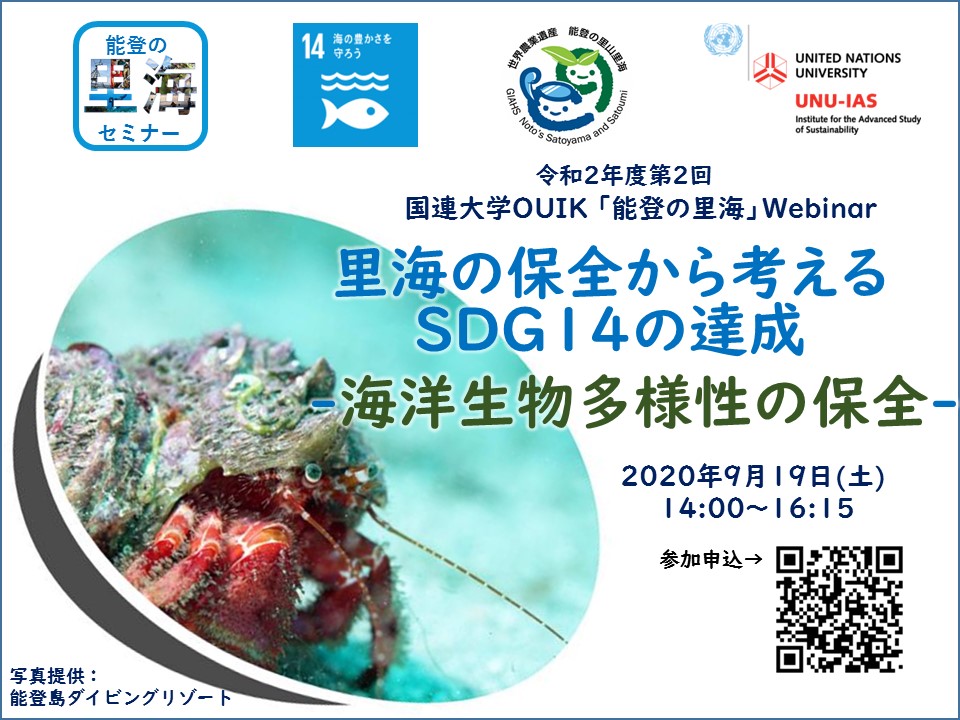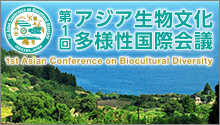At the 2nd Satoumi Seminar, we learned about SDG 14.2 and 14.5, individual targets of SDG 14 which concern undertaking initiatives to help recover and strengthen the resistance of marine and coastal ecosystems and contemplated how to help preserve marine biodiversity.
First, Research Associate Evonne explained the purpose of the seminar and what conservation of marine biodiversity means in the context of SDG 14. “In the Satoyama and Satoumi region, the forests, hills, rivers, and oceans are all connected, so even while living on land, if you have an awareness of your connection to the oceans you can still contribute to their preservation. If many people work together, we can continue to protect the Satoyama and Satoumi,” she explained.
Next, Mariko Kimura (Nature Conservation Bureau, Ministry of the Environment) gave a keynote lecture focusing on the three topics of “Currently Protected Marine Areas,” “The New System for Offshore Protected Areas,” and “Protected Marine Areas from Next Year Onwards.” She said that she would like everyone to think about how the protection of the oceans can be achieved through their sustainable use by maintaining the connection between people and the environment; in other words, that people interacting with the oceans can help protect them, and that it is difficult to protect them without having any interaction at all.
Next, Seiji Yanai (Professor, Ishikawa Prefectural University) gave a presentation on his activities titled “The Connection Between the Forest and the Sea Mediated by the Akategani Crab in Noto’s Tsukumo Bay.” Every year, many Akategani crabs flock to the Tsukumo Bay to lay eggs, and many kinds of fish also gather to eat those eggs. Professor Yanai suggested that the Akategani crab is an animal that represents the connection between the forest and the sea, and that it may be useful as a subject of study for environmental education. He also runs a public coastal learning exercise at Kanazawa University, in which they use abandoned rice paddies to create biotopes for Akategani crabs.
Next, Minoru Kamamura (Notojima Diving Resort) gave a presentation on his activities titled “Connecting with the Biodiversity of Noto’s Satoumi as a Diver.” Kamamura has been operating a diving shop on Notojima, located on the East side of the Noto Peninsula, since first opening it 17 years ago. On the topic of the importance of marine biodiversity he said, “There are many different varieties of seaweed, which in turn attract many different organisms. The presence of seaweed and many small fish and shellfish is what keeps the water clean. Leisure diving is reliant on that beautiful natural process.” Kamamura also cooperates with local high schools’ diving teams to do surveys of the marine environment and clean up trash.
Research Associate Evonne then moderated a panel discussion in which the panelists answered viewers’ questions and viewers shared their thoughts and opinions. One viewer said, “Once you realize that life on land is connected to life in the sea, you want to protect the sea. Today’s discussion made me feel that it’s important to think about both life on land and life in the sea at the same time.”
In his closing remarks, Tsunao Watanabe (Director of UNU-OUIK) said, “Through today’s discussions we learned about many important points of view for thinking about how to continue to preserve marine biodiversity. The Noto Satoyama Satoumi is an extremely important region that has been designated as a GIAHS. I think it would be a wonderful thing if everyone were to take part in initiatives to improve our relationship with the sea as we cherish the connection between the forest and the sea.”




